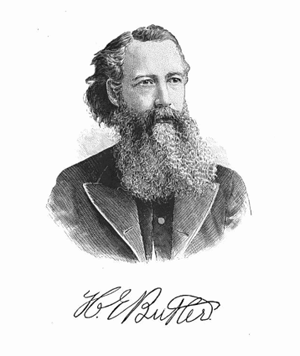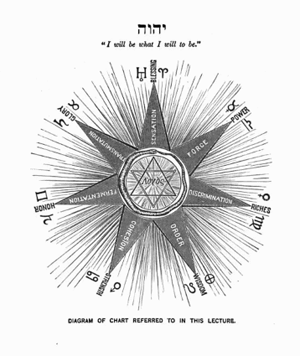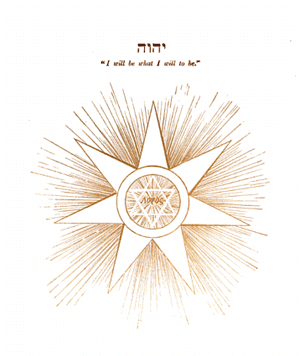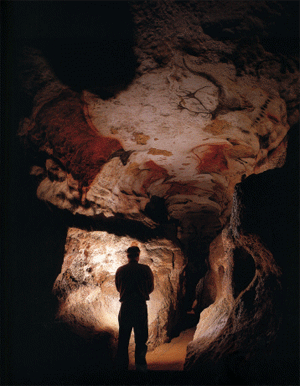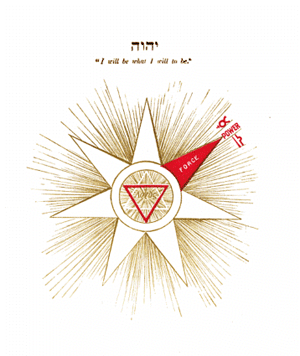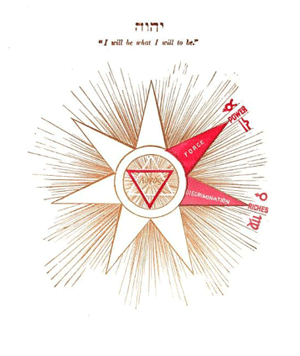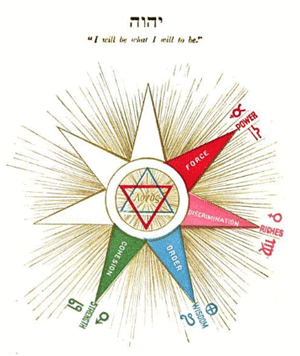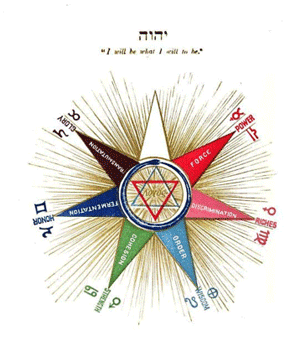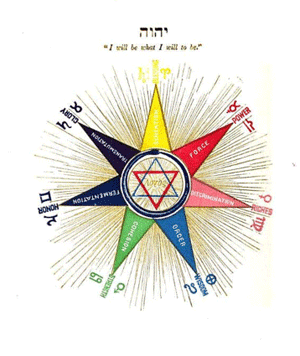FOURTH LECTURE.
ORDER.
THE THIRD OF THE CREATIVE PRINCIPLES.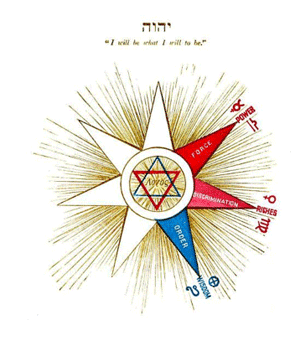
These thoughts on order, the third principle of creation, lead us to consider its first manifestation in nature. Having laid down a foundation-principle in the first lecture, on "The Idea of God," we are now ready to present a more complete understanding of this third principle in its unity with the other two. Now, this third principle, united with the two previous, brings us to manifest organization. In its first phase the atom is polarized and endowed with order, and, by virtue of their innate endowments, form into orderly structures by the action of cold and heat.
How many times have I stood, in my childhood, also in manhood, and looked upon the pictures drawn by the Divine Artist, as the frost gathered and pictured upon the window-pane beautiful swamp-scenes, where the forms of vegetation in great variety were represented. Again have I paused as I walked along the streets, after a rain followed by freezing, where the water, by virtue of the cold, had concentrated and congealed, and stood out upon the pavement in the form of a beautiful vine or a lovely tree, thus imaging the growth of vegetation. And, as I looked upon these scenes, my thoughts at once went back to
the mind that endowed matter with this potential, orderly energy.Jesus, the Nazarene, expressed but little more when he said, "As the Father hath life in himself, so hath he given to the Son to have life in himself."
And as the Father and author of all being has life, order, mind-power, and intellect in himself, so all that emanates from that infinite mind has the same attributes innate in themselves; therefore, as we walk through this grand old earth of ours, and see the beauteous structures created by this in-dwelling divine mind, how can we help but worship. But, as we see the frost gathering upon the window-pane, or upon the flag-stone, or congealed in the tumbler or in the creek, those beautiful forms have but three principles combined; therefore, these crystals are not substantial, but as soon as the fourth principle is added to them,
the principle of cohesion, which in itself is heat, it at once dissipates them; it becomes a destroyer; it tears down and prepares them to come up in vegetable life, where they can be further matured.
These two forces, the positive and the negative, cold and heat, are the formative agents of nature; and, wherever they meet and produce these sub or transient formations, they leave the essences of such endowed with a principle of life that causes vegetation to spring up and life to be manifested in all its various forms in nature. These principles, of which order is the third, are active in the formation of all crystallization, and we find them manifest in minerals, where the different chemicals combine, and crystallization takes place; and in each case they assume a definite form, according to quality.
Every crystal that is possessed of perfect essence — that is, where the law of discrimination has its full force — will take a regular shape. Probably all of you have seen those beautiful crystallizations brought from the West and elsewhere, where they have formed the octagon, and the different angles and ovals, and all the various shapes, as accurately as if they had been made by some artisan, and had been formed for an express use.
We cannot but admire and wonder when we look into nature, and see in it these beautiful expressions of the infinite mechanic that are so like the effort of the human hand and brain.As we consider the law of order, it leads us further into the realm of vegetable life, where we see atoms gathering together, taking shape, coming forth in the form of whatever quality they possess; and
here we see the trinity of principles. First, the solids are concentrated by force; by the maternal or mother-principle the magnet thought draws together and inspheres and binds; then comes the second principle, discrimination, giving it polarization, when it begins to resist the concentrative power; and then comes in the master-workman, order, and calls everything into its place. Discrimination came, and said, "This atom must not be gathered up by this, and this must not be gathered up by that"; then order, says, "This belongs here, the other belongs there"; and so goes on the work of both, so that, two seeds of a different nature being planted side by side, the same water will nourish them, the same soil will supply their common needs; but each of these, by virtue of their discriminative power, will reject certain chemical elements, and,
by order of the master-workman, they take others, carry them to their destination, and deposit them in their place, the one chosen by the great architect of nature. Should there be something that would interrupt the workings of the law of order in matter, we would see at once that there was malformation in plants, trees, and animal life, such as abnormal growths, knots on plants and trees; also, false growth in animal bodies. These are the workings of the three principles:
the first collects the elements; the second selects the qualities; and the third takes them and places them where they belong. Can there be found a principle in mechanics working together with greater harmony, with greater accuracy, than these principles work, in their chemical selections, and in their orderly structure-building? I think not.
We cannot but admire and wonder when we look into this process, and see a mind at work there whose capacity so far surpasses the human intellect. This law of order, united with the other principles, gives every plant, every vegetable, and every animal their distinct form, by virtue of the quality of the germ-life coming from its parental source. That germ-life has been organized with power to gather around it like elements, to mature principles of which it was the expression, and it always carries it out to the letter of the law, making no mistakes; so we are in the habit of looking into each other's faces, and saying, "You look like your mother," and "you look like your father," and so on. Again, we look into each other's faces, and we read there the nature of the person. We say that person has something good; that person is disposed to live in this or that way. How do we know? We know only because
this divine architect has done his work perfectly. He has made no mistake; he has expressed his thought in perfect language.
Not only has he done this so that we may read character from physiognomy or phrenology of mankind, but this principle of reading character from the language of form, was the first principle of thought. As animals came into being on this planet and began to devour one the other, self-protection became the one thought most necessary; and in the work of self-protection there came fear, and they at once began to take cognizance, and to look at and judge of the objects that were approaching them, whether they should fear them or not.
Furthermore: "This is the book of the generations of Man", viz. the book which reveals the inner meaning of the features of man, so as to teach the knowledge of human nature. The character of man is revealed in the hair, the forehead, the eyes, the lips, the features of the face, the lines of the hands, and even the ears. By these seven can the different types of men be recognized.
'The Hair. A man with coarse, upstanding, wavy hair, is of a truculent disposition. His heart is as stiff as a die. His works are not upright. Have no fellowship with him. A man with very smooth, sleek and heavy-hanging hair, is a good companion, and one benefits from association with him. When left to himself he is not quite reliable. He cannot keep secrets unless they are of great importance. His actions are sometimes good and sometimes the reverse.
'A man whose hair lies flat, yet is not sleek, is fearless and insolent. He has a strong desire to do good, for he perceives the beauty of goodness, but alas! his good intentions are never realized. In his old age he becomes God-fearing and pious. Great secrets are not to be entrusted to him, but he is safe enough with small ones. He can make much out of little and his words are listened to with respect. He is under the esoteric sign of the letter Zain, according to the scheme which our Master has taught us.
'A man whose hair is black and extremely glossy will succeed in all his doings, particularly in secular matters such as commerce, for instance. He is generous. But he prospers only as an individual; anyone associating himself with him will also have success, but not for long. He is also under the letter Zain.
'One whose hair is black but not glossy is not always successful in mundane affairs. It is good to associate oneself with him for a while in business matters. Should he be a student of the Torah he will succeed in his studies, and others who will join him will likewise succeed. He is a man who can keep a secret, but not for long. He is of a despondent nature, but will prevail against his enemies. He is under the sign of the letter Yod when it is not included in the letter Zain, but is numbered independently among the small letters.
'A man who is bald is successful in business, but is not straightforward. There is always a scarcity of food in his house. He is hypocritical; that is, when his baldness begins in youth. If he becomes bald in his old age he changes and becomes the opposite of what he was before, for good or for ill. This, however, only refers to the baldness which occurs on the forehead, at the spot where the phylactery is put on. Otherwise, it is not so. He is not deceitful, but is given to backbiting and insinuation. He is occasionally sin-fearing. He is under the sign of the letter Zain when it includes the letter Yod. So much for the mysteries revealed by the different kinds of hair, mysteries revealed and entrusted only to those well versed in holy lore, those who comprehend the ways and mysteries of the Torah, by which they may find out the hidden propensities of men.
'The forehead. The secret of the forehead belongs under the sign of the letter Nun, which forms the completion of the letter Zain; sometimes this is included in the symbolism of Zain and sometimes it stands separately.
'A forehead which rises sharply upward from the nose, being straight and flat without any outward curve or rounding, indicates that its owner is somewhat thoughtless. Such a man will consider himself wise, though in reality he knows little. His temper will be quick, and his tongue like a serpent's. If his forehead has large uneven furrows when he speaks, but other lines on his forehead lie even, he is not a person to associate with save for a brief period. Whatever he plans or does is only for his own advantage; he cares for no one but himself. He is incapable of keeping any secret entrusted to him, and the saying, "A tale-bearer revealeth secrets" (Prov. XI, 13) is true of him; indeed, he cares not what he says. This type of person belongs to the mystery of the letter Nun when it is contained in the letter Zaino Such a one may be thought of as anything but reliable.
'A fine and rounded forehead indicates a man of great penetration, but whose judgement is sometimes clouded. He loves cheerfulness, and is kindhearted to all. He has high intellectual interests. Should he study the Torah he will become very proficient. When he speaks three large wrinkles appear on his forehead and three smaller ones above each eye. If when he is angry he weeps, he is better than he appears to be. In word and deed he is forthright and cares nothing for anyone. He will study the Torah with profit. Anyone who allies himself with him will derive benefit from the association and will profit even in secular matters. He is not consistently pious. In legal affairs he will always be unlucky, and should therefore avoid such embroilments as far as possible. This type stands in the symbolism of the letter Nun alone when it is not included in the Zain. It is for this reason that he must shun legal matters, since he does not belong to the region of justice, but to that of love and mercy.
'A person whose forehead is large and yet unrounded -- the kind of man who always bends his head, whether he stand or move-this type can be divided into two classes, both witless. The madness of the one is evident, apparent to all; such a person is an acknowledged idiot. On his forehead are four large wrinkles, which usually appear when he speaks. Sometimes, however, the skin of his forehead is stretched and the wrinkles are not evident, but other larger ones appear close to his eyes. He laughs for no reason, and at nothing. His mouth is large and loose. Such a man is of no worth or use. The other kind of madness included in this type is less apparent, and is unnoticeable in common intercourse. Such a man may pursue study with success, even the study of the Torah, though he will not take it up for its own sake, but only to make a show. He makes a great parade of his religion, to give the impression that he is deeply pious, but in reality he has no thought of God, but only of man. The one object of all his thoughts and behaviour is to draw attention to himself. This type, with its two distinct variants, also stands under the sign of the Nun when it is contained in the Zain.
'A large rounded forehead indicates one who is open-minded and generally gifted. He can acquire any kind of knowledge, even without a teacher. His undertakings are uniformly successful, except when they are concerned with money matters, in which he sometimes comes to grief. He can infer great things from small; hence he is rightly called discerning. He is detached from the things of this world, and even when he knows that he will suffer by not considering earthly matters he pays them no heed. He is tenderhearted. His forehead is deeply furrowed by two wrinkles, set high upon his brow, one over each eye. His forehead also has three long lines, and between his eyes is the double vertical furrow which signifies deep thought. He is always concerned with realities and not with appearances, because he does not care what men say about him. He is never afraid for long. He is very conciliatory. To outsiders his acts appear sometimes childish and sometimes wise. This type also stands in the sign of the Nun when it is separated and not included in the Zain. So much for the mystery connected with the study of the forehead.
'The eyes. The eyes are connected with the symbolism of the letter Samech. There are varieties of colour and of form. In the substances which go to compose the visible discernible eye are contained four colours. There is the white of the ball, which is common to all sorts of eyes. Enclosed within this white is the darker hue of the iris -- thus white and dark are united. Included in this dark there is yet another shade, a bluish tinge; and the inmost circle of colour is black, this being the pupil.
'A man whose eyes are evenly set is straightforward and free from guile. A person with such eyes is always merry and full of jokes. He has good intentions, but seldom carries them out because of his fickleness. His mind is chiefly occupied with worldly things, but he has the capacity for spiritual matters if he should turn his thoughts towards them; therefore he should be encouraged in this direction. His eyebrows are long, slanting downward. In the midst of these several colours of the eye are sundry fine red veins, which are called the "small letters" of the eyes, because, when the colours shine, [73a] their light causes the letters to be revealed in those veins to the initiated, these veins being formed in the shape of the letter Samech when it contains the letter He.
'A man who has blue eyes set in white will be of a kindly disposition, but at the same time selfish. If the black is not noticeable in his eyes he will have strong desires, but not for evil, though he will not resist evil when it approaches. He can be trusted when he speaks of matters within his own knowledge, but not otherwise. He can keep a secret so long as it is a secret, but once it has leaked out he tells everything, since he does nothing perfectly. The colours of such an eye and the type to which its possessor conforms are contained in the mystery of the letter He when contained in the letters Zain and Samech.
'He whose eyes are of a yellowish-blue colour has madness in his veins; he therefore suffers from megalomania and is grandiloquent in his manner and speech. In discussion he is easily defeated. He is not worthy to be instructed in the mystical meanings of the Torah, as he does not accept them meekly but becomes puffed up with his knowledge. This type belongs to the mystery of the letter He, which is included in the letter Zain only, being far removed from the letter Samech on account of his conceit. When such a man speaks, many wrinkles appear on his forehead.
'One whose eyes are pale with a certain admixture of a greenish hue is of an irascible disposition, but is also often kind-hearted enough. When angered, however, he becomes cruel. He cannot be entrusted with a secret. He belongs to the sign of the letter He when it is included in the letter Samech.
'The man whose eyes are white and blue, with only a spot of black in them, can be trusted with secrets and makes good use of them. If he makes a good beginning in anything [73b] he goes on prospering. His enemies cannot prevail against him, they can do him no evil, and eventually they are entirely subdued by him. He is under the sign of the letter Kaph when it is included in the letter Samech.
'So much for the mysteries concerning the eyes, which are revealed unto the wise.
'The lineaments of the countenance. For the masters of the inner wisdom the features of the face are not those which appear outwardly, but those within formed by internal forces; for the features of the face are moulded by the impress of the inner face which is concealed in the spirit residing within. This spirit produces outward traits which are recognizable to the wise, the true features being discernible from the spirit. Man has a spirit on which the letters of the alphabet are in a way designed. All these letters are enclosed in that spirit, and for a time the designs of those letters enter into the face; and as they enter, the face appears with the design of these letters upon it. But this semblance lasts for a short time only, save upon the faces of adepts in wisdom, on whom it is always visible.
--
The Zohar, translated by Harry Sperling and Maurice Simon
Thus, animals began to recognize the image of a thing before they did the nature of it; this must, of necessity, be the first starting-point, — that of judging from physiognomy, as we call it. We go into the woods, and the wild beasts know each other. Some will feed together because they realize that they do not antagonize each other, and, as soon as an antagonistic beast comes along, they flee for their lives. How do they know? Here, again ,
the language of form stands out, and they know from the image what is combined and embodied in the form. They know, at least, this, that it is a form of antagonism and destruction to them.
Thus, the faculty of mind in man to-day, that enables him to judge of things and qualities by form, is the most perfectly developed faculty in the human brain; and this should be the one that we utilize to the greatest advantage. In my thought and study, years past, I saw that every line upon the face spoke a language; and every mark that comes there, without injury, tells a story; it speaks of some in-working principle. Yes, every line upon the hand is a hieroglyphic that tells of one's minute character; even the formation of the nails on the fingers, the shape of the hand, every minute particle of the man, reveals the character therein expressed. Think of such a mechanism! Think of a mind that is capable of causing nature to come together so perfectly in accordance with the language of its own inner being! This lesson is ever before us, we see it on every side; and the more we think upon it, the more will we realize its truth.
We go into the woods, and, whilst among the trees, we find, springing up, a little leaf. We do not know what it is; to us it is mute. We present it to a botanist, who makes a story of plant-life; he observes its color, its outline, the lines upon it, the thickness, the little fibres, — all its minutiae unite together to tell him the history of the plant to which it belongs. Then, at once, he becomes a prophet, a fortune-teller, and tells you that if you see that shrub in the fall, when it is fully matured, you will find on it berries of such and such qualities, and that it possesses such and such chemical properties, etc. He can tell you everything about it, just from one leaf. Think what an orderly workman Nature is! We do not find thistle-leaves on apple-trees, nor cabbage-leaves growing on potato-plants.
We do not sufficiently consider the wonderful wisdom that is working under this divine order to cause the chemistry of this world; the molecules fly through the atmosphere, seemingly without any government; the wind sweeps hither and thither, everything apparently going by chance, all being hurled together here and there; but stop!
In it all is that wonderful mind — that wonderful mechanic — that, no matter how it is hurled together and mixed up by the upheaval of forces, and cyclones of wind and storm or rain, it never makes any mistakes, but always gets everything in its right place. Now, the human mind has the most perfect development in that function, more so than in any other of its nature.
That function is the one that has built our railroads; that has made up our mechanical interests; that has actuated the workingman, as he hewed and chopped away at the great oaks that once covered this land, who squared and built them into the crude houses, — the law of order in the brain of that mechanic enabled him to rear the structure.
But, look again; he conceives a way of obviating much of this hard labor. He goes to work and invents machinery; he carries this divine order that he sees everywhere working in nature into a mechanical device to do his work, to save his strength, to relieve his muscles.
On and on we have gone, until now the more subtle forces of nature are under our control. By bringing into orderly forms certain mechanical appliances we control the lightning, bring it down, and make it our errand-boy to carry the messages, not only from house to house, and from one city to another, but through the very depths of the great ocean, from shore to shore. This is the law of order, as it is working in the human mind. It imitates nature, and observes cause and effect, how one thing acts upon another, produces combinations like the machinery of a watch, or other machinery where speed of movement is required, and where the cogs, intercepting each the other, each wheel must have definite proportion to the other. For, if they lessen the one and increase the other, they increase the speed; herein the human brain begins to imitate the divine architect. But this imitation goes but a short distance. It simply takes the material that has been created by that divine power, and forms the structure for us by physical or mechanical effort; but there is a step beyond this, — that is, if we carry out the imitation of that divine mind, — that is, the workman in nature.
We do not see a man-god coming down and, by his hand, taking these atoms and putting them in their place, and giving them form as a child would build cob-houses; but
we perceive a mind-power that is enabled to send forth thought, to endow nature with that tendency to cause a world to build itself, and not only to cause a world to be built, but regulated and controlled in all the minutiae of structure. After we have scanned all the visible objects on the planet earth, we have taken only the first step toward beholding all that there is. "We take the magnifying lens and a single drop of water, and discover there is a little world within itself, all filled with active, organized life. This great mechanic has gone down into minutiae, where it takes a lens magnifying seven, eight, and ten thousand times in order that our eyes can discern what is going on, and yet this wonderful mechanic has gone to work there, has made a structure that is perfect; yes, and sometimes, as we scan those beautiful little things, we think that nature has been partial to them, because of the beauty, agility, activity, and vivacity that they manifest. Now, if we turn from this small world and direct the telescope to the heavens, there again we find the architect and mechanic at work. All is order, perfect order, perfect harmony. There we find other worlds, hundreds of times larger than our own, indications of far greater complications in their workings; suns millions of times larger than our world, and these all flying through space with lightning speed; suns and systems of worlds moving around their centres. To think of this intelligently, to realize it, we stand in awe at such a presence, — a presence that is even under our feet. As we stand upon the solid earth, that divine principle is changing the grains of sand upon which we rest, taking of their qualities; and, notwithstanding we are pressing upon them, they are actually changing and being built into other forms.
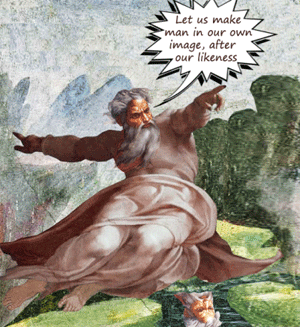 All narcissists are merely reflections of the One Great Narcissist, by Tara Carreon
All narcissists are merely reflections of the One Great Narcissist, by Tara Carreon
We are told, in the Hebrew Bible, that the declared purpose of God was "Let us make man in our own image and like us; and let him have dominion over the fish of the sea and the fowl of the air, and over all the earth." That is very sweeping, — "all the earth;" and such words from a mind that is so discriminative, so orderly! What a declaration from such a source, that these microscopic objects, those mighty suns and worlds, every objective thing, with their governing law and creative engines, — man to have dominion over all this! "What kind of man would this necessitate? How many, many millions of cycles must pass, ere such will be manifested on this planet?
But let us consider this subject from another point of view: the habit we have formed of recognizing friends, of determining qualities in persons, in animals, in things in general. This habit we find so established that it goes on imaging, even in our sleep, so that, if we dream, the act of dreaming is to see images. What is a dream? Perhaps we are lying in our beds, resting quietly; but, whilst we dream, we see ourselves somewhere, perhaps in danger, struggling with antagonistic forces, their images appearing to us, perchance as wild beasts. How real it all seems to us for the time; and in the struggle, perhaps, we wake up, come back to our normal consciousness to find that it was not real. What has caused it?
The physician will tell us there was a derangement in the digestive forces; there sometimes is; we find that, if we have taken something into the stomach that has chemically fermented and produced gases foreign to our nature, these elements or gases press upon the brain. The brain is thus forced to act whilst the body sleeps, and it images forth the antagonistic essences that are generated in the body; and, if it were possible for one to be so fine a chemist as to be able to trace the workings of this law of order to the very animals that you saw in your dream, you would find there was some bond of relatedness and chemical cause for the objects imaged, that the chemical nature of the beast seen was like that produced in the stomach through the derangement. This is where the law of order is interrupted in the digestive function, which works faithfully on the brain. When we have become the wonderful chemists that we shall be some time, we will then know just exactly what chemical properties produce each given result upon the mind as well as upon the physical body, so that we will be enabled to extract the thought-essence that produced the plant, and then the contact with the human nerve will produce like thought-essence and imaged likeness.
I told you there are but seven creative principles in all nature. No matter where you go, these, in their different combinations, produce all the qualities that there are.
But, whilst these seven are creative principles, they are not qualities of things; for qualities of things are wholly related to conditions in the stages of transmutation. Transmutation goes to a higher degree in some natures than in others. The chemistry of the body is more perfect in some organisms than in others, and, therefore, it does finer work; so the difference in quality that we find in matter is owing to the stage of change or unfoldment.
We find these elements and chemicals in the sun-ray and in the atmosphere above us.
As the worlds are changing in their position, the solar fluid is being changed and altered systematically. According to this definite mechanical law there are constantly changing thought-potencies being imparted to the world; and, as these changing thought-potencies are received, it affects all vegetation and animal life. When the human mind is perfected to a greater degree, and has become polarized on the God of the universe, as was the mind of the Hebrew prophets, whose desire was to know the ultimate and future of this world, and the object of creation, then, musing upon the cause of the wonders of creation that we see around us, endeavoring to rise higher and higher, we shall get above this fermenting mass, and, as with them, so this imaging power that does its perfect work in nature will continue to do its perfect work in our brain. With them the life-forces were more and more perfected until they were so refined in their life that they could sense the very essence of the creative mind, — the mind of the great workman that we see forming and arranging and controlling this wonderful workshop, nature, and causing it all to work together toward one great object. Thus they, by constant meditation, were enabled to actually sense that mind, to actually collect and think the thoughts of this Infinite Soul, long years before they had wrought out their ultimation in physical form. For, through aspiration, they collected the creative thought; it took image in their brain, and was clothed like a seed with their essence, and prepared for its descent into matter, the same as a seed is clothed with a shell to prepare it for the earth.
So the thought, emanating from the infinite mind, that was sent earthward to bring into the world an order of humanity who should enact certain parts in the great drama of life, in order to produce desired results upon this planet, was collected, imaged, and realized in their minds.
This imaging power of the brain, when once we are capable of sensing these infinite thoughts, will put them into their exact image, and there will be no mistake. They will accomplish their work; and, if we should live a thousand years, and at the end of that time see the image of our vision standing forth in human form, we would know it, and if we could have had a photograph taken from the image in our mind, we would say, "There is the picture, accurate; every part and particle of it is exact."
Again,
we go among a class of people known as spiritualists, who have begun to feel after and inquire about these strange workings of the human mind. We go to a clairvoyant, and sit down before him or her, and they begin to tell us of the images that present themselves to their minds, and as they do so they attempt to explain them to us. Now, what is going on, and what is there real about it?
You have around you certain mental conditions, perhaps the souls of some departed ones whose thought-potency clings closely to you. They sense it. They see forms standing before them and describe them perhaps accurately. By what means? By this imaging power of the brain. You take a letter, a lock of hair, a glove, a garment, that some loved and lost one has worn, take it to a psychognomist, who takes it in hand, and says, "I see such and such a one," drawing the picture, clear and unmistakable, of your lost one. " Yes, I know whom you mean; I know all about it; I know the person well; that was such a one."
What has taken place? Why, there was enough of the magnetic life-essences of the thought that had been formed in the life and action of that person, left attached on that garment to enable this sensitive brain to draw it in; and, as it did so, it would be able to see an unmistakable image of the wearer. This is a law of the infinite order that is active in us.
It is not every brain that perceives things or makes its images alike. As some have different functions, so this imaging power varies in different minds. Sometimes it is the order of sound, in others color (for order has a color, and color has an order, as we will see when we come to consider the cause of the seven colors). But, remember this, it is not necessary that we should have the soul of the departed come and present itself to the spiritual eye in order to see it; for we can prove by the glove or the garment that the image-power of
the brain can take the little magnetic molecules of thought and give you the picture of the person from whose body they emanated. Here we see something of this divine mechanical power in each of us. It knows exactly what to do with every particle of this ethereal essence that comes in contact with us. It is a mechanic, indeed. It images a person, an animal, in an instant. It produces birds, reptiles, everything in its proper order.
The moment the element, the ether, if you please, whose nature it is to form such lives, comes in contact with the imaging power of the brain it makes it into the appropriate image in a minute: shall we say it deceives us? I think not. But, certainly, we could not make the image unless we had the proper material to work with. You can never see the image of your father, or your mother, or your daughter, by taking the glove or handkerchief that has been endowed with the magnetism of some other person, unless you do so by a thought projected from your own mind. The law of order in the mind of man works in exact accordance with the above rules. By tracing this law of order in its growth and unfoldment, and manifestation in the physical world, we have the explanation of all vision, of all these mystic and, at present, largely uncomprehended phenomena of the human mind. Here we will find the uses of thinking over the relations of these seven creative principles; for, remember this, friends, the God of creation does not deal with persons or things arbitrarily, but through the action and operation of these seven principles, which, in time, reveal their workings to the higher consciousness; this by virtue of constant practice, constant use, generation after generation, for ages up to the present time, has produced in us a certain likeness to the author-mind from whence we came;
consequently, the mind begins to act like its parent, or, in other words, the man begins to look like his father; and Christ well says, "Call no man your father, for one is your father, even God." And here we find the first manifestation of the sixth sense, and of the God-principle in its sublimated expression of the law of order in the human mind; and
it is in conformity with this law that mind acts on mind, and that, within certain limits, we have the power to appropriate or reenact the manifestations of the seven principles from our higher nature.To a very great extent, in our large cities, we are in a sea of psychic influences from the masses, and to such an extent that it is only by a constant struggle or effort that we can act from our own nature; and the finer persons are, the more they are affected by the influences. We would be surprised, if we were separated from those altogether, at the change that would be produced; we would then discover how much we are acting from the influence of other minds.
Persons who are fine and sensitive are often afflicted with disease through the controlling influence of low or evil-disposed persons; for, when the mind is under control of another, it affects the discriminating power of the digestion, and causes the persons to take into their circulation like elements to those who, for the time, control them; these elements are poison to them; thus disease is often produced, and sometimes death.
Humanity is involved in series, and stand intimately related each to the other, and thus we are constantly being acted upon by minds both above and beneath us; and, were we isolated from this magnetic relation with other minds, we would be astonished at finding how dependent the individual is; in fact, apart from the series of which we are an entity, individuality would be a mere cipher. We derive value and importance from discrimination and orderly adjustment and coherence to the force around, within, and above us, and may elect to work in a low or a high series the same as we discriminate and select in matters of diet and clothing; and this is a most important thought to keep in mind.
We may, therefore, be interiorly poisoned and paralyzed, or nourished and exalted, according to social, mental, and spiritual discrimination. These laws are absolute and eternal facts of nature, and cannot be controverted or ignored. Then why should we, as thinking men and women, when we see this law acting in this subtle manner in the human mind and nature, say it is all a delusion. We may delude ourselves with the phenomenon of the most simple things; but, when we stop and think, these are the means, this is the law, here is the power, and, according as we select, so are we servants or masters.
We are already joint-creators with the infinite mind. We are not conscious of it, because these creative energies that come from the infinite will come down to us through their successive stages, float through the successive degrees of mind and mechanical life, being fitted and prepared for their material use.
Let us, then, begin to gather of the creative energy, and think its thoughts; and, as we do so, we throw off this surplus life, and animals and plants gather it up and make their bodies out of it, and so on, down and down, until it moves and moulds even gross matter. We stand here in this chain of existence, reaching from the Infinite Unknowable to the lowest, and every link of that chain is a stage of animate unfoldment. Man stands just between the animal and spiritual, or God-world, as we call it; and, because of our capacity to feel, to see, and to handle
those finer forces that are above and beyond us, they are just far enough so that we can reach and touch them, can receive of their thoughts, and then we bring them down into the lower faculties of our nature, and in turn aid those just below us, the higher faculties of whose being are capable of receiving these thoughts from us, and again carrying them down into the lower faculties of their nature, which are enabled to receive according to the uses and needs of their position.We are standing in direct lineage to the God of the universe, being a joint-creator with him. All there is remaining for us to do is to go to work on self, clear away these gross elements of our being, get our minds refined, give the soul an opportunity to think and act freely, and then we will be enabled to follow the advice of the Nazarene when he said, "After this manner, pray." Yes, continually we will say, "Our Father, who art in heaven." But now, in this gross condition of the world, when none can realize spirit, — and God is spirit, — how then? Is it real, or is it hypocrisy, when we say, "Our Father, who art in heaven," and yet do not realize or believe it, when we have no idea of what spirit is, — no idea of that heavenly Father? Prayer is the sincere desire of the heart, the soul-yearning, the reaching out of the inner self towards something that it feels the need of. Can we truly feel the need of that we do not know anything about? Certainly not. The very foundation of the Christian religion demands that we should understand these laws and principles, and put them into practice, before we can take the first step in it, which is to "pray."
When we recognize these things in the divine law of order, and our inner consciousness is open, so that the soul does actually recognize the source of its being, as the child recognizes its parent, its father, its mother; then, with this evidence, it reaches up and says, "My Father, let thy kingdom come, that thy will may be done on earth as it is in the heavens," and is ready to labor for that ultimate in himself, and
when all our thoughts and desires are concentrated on knowing the ultimate of this divine order on earth, we will possess the true Wisdom.


